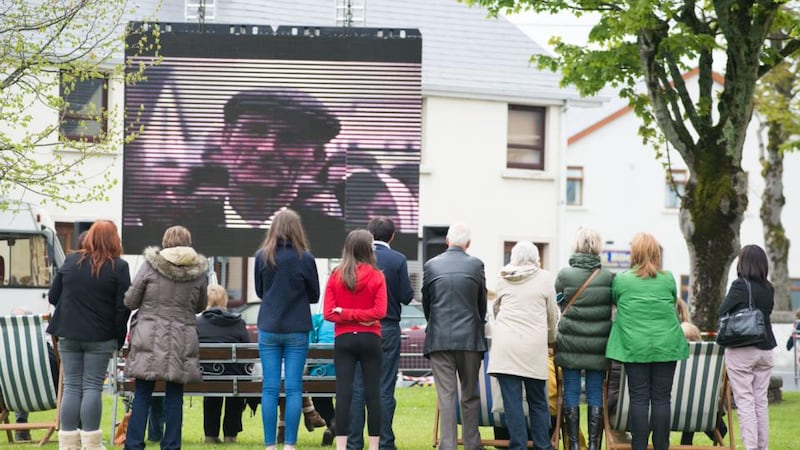There were two film festivals taking place in Europe the last few days. Both featured rain, coveted trophies, and eye-catching modes of transportation.
Cannes had stars gingerly navigating a soggy red carpet, the Palme d’Or, and incongruously expensive yachts in its harbour, but Malin’s Guth Gafa documentary festival, in Donegal’s far north, matched it. The deluge that descended on Saturday turned the village green into a pond, the trophies displayed in a cabinet in the festival marquee were for local Tidy Towns awards, and tractors and diggers periodically circled the green. Most importantly, both showcased excellent, thought-provoking films.
This is the seventh year of Guth Gafa, the three-day documentary festival aimed both at the industry and members of the public. Co-directed by David Rane and Neasa Ní Chianáin, the festival featured 26 documentaries, and a number of workshops and panel discussions, some of them in partnership with the Foyle Theatre in Derry, as part of their City of Culture programme. Eighteen of the 26 films were Irish premieres.

To achieve all this on a total budget of only €75,000 was a highly impressive achievement for a cultural event in such a remote location, which drew audiences of over 2,500 people.
“It’s only possible because of all the volunteers, and the people who work for minimum wage for 10 weeks,” reported Rane, who was anxious to acknowledge the support of his dedicated team.
Malin village does not have a permanent cinema, but last weekend there were five locations where you could watch films. They were the cinemobile, the Malin Hotel function room, a beanbag room in the former court house, the village parish hall, and an optimistically-located outdoor screen on the green.
Family, place and local traditions were the loose themes running through the festival. Most of the documentaries were followed by and Q&A session with a key person who had worked on them, which immeasurably added to the overall experience. In the case of Sons of the Land , a French film, it was director Edouard Bergeon.
About 800 farmers in France a year die by suicide. His gripping documentary follows 14 months in the lives of the Itards, where parents and middle-aged son Sebastien battle about inherited responsibilities, family relationships, debt and the future of the troubled farm. It also explores his own family’s parallel experience. During the time Bergeon shot with the family, Sebastien Itard himself attempted suicide.
“It was easy to find this family,” he told the clearly astonished audience afterwards. “There are so many other farming families going through the same thing, and it shows in 13 years, nothing has changed in France.”
The documentary that attracted most interest from audiences and sold out fastest was More Than Honey , by Swiss director Markus Imhoof. We all know the bee population is in grave and mysterious danger, and that a drop in bee numbers has an adverse effect on the world's food production. What this documentary does is explain why, with extraordinary footage from Switzerland, China and California's vast almond farms.
Thanks to tiny bee-mounted cameras capturing bees in flight, GPS tracking, cameras in hives and other technological wizardy, audiences came as close as possible to actually being inside the hive.
The film shows how the bee industry has become a vast globalised commercial industry, far removed from the rural idyll image of single hives in gardens. The use of pesticides is explored, as are attempts to breed strains of bees that can survive the spread of the deadly varroa mite. The stand-out scene is so surreal it seems fictional, but is sadly not: a flowering orchard in China being hand-pollinated by scores of workers, due to the lack of bees to do the job naturally.
“We don’t think anyone else has this footage from China,” cinematographer Jorg Jehsel told the audience afterwards. As to the question of how you make a camera follow directly behind the flight of a bee? “You attach a tiny thread to the bee in the studio at a fixed point, and the camera follows it as it goes round.”
One of the most startling subjects was transhumance in modern Switzerland, as seen in Winter Nomads . Transhumance, the practice of moving animals over land, and letting them graze along the way, is medieval in its origins. But it still – just about – exists in Switzerland.
This year's Oscar-winning documentary, the charming, feel-good quest narrative, Searching for Sugar Man , was also screened. And no, director Malik Bendjelloul wasn't in Malin. He was in Cannes. Maybe Guth Gafa can nab him for next year's festival.













